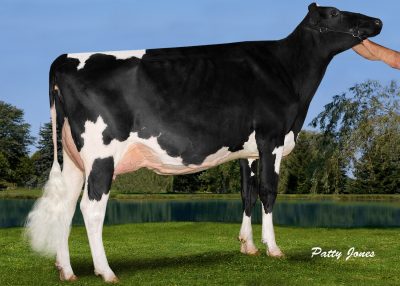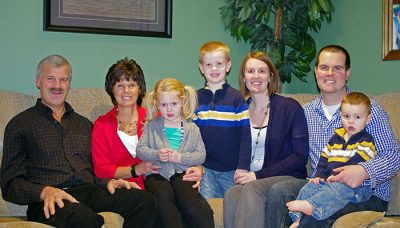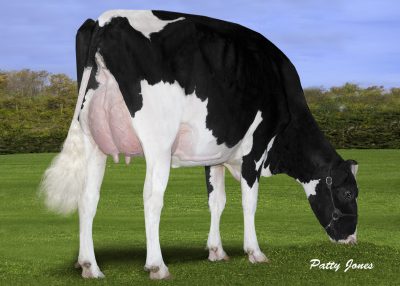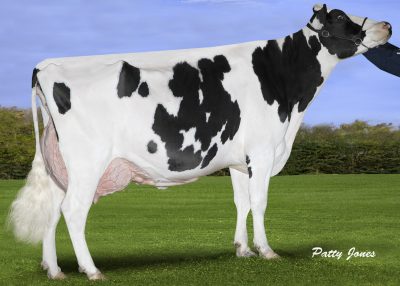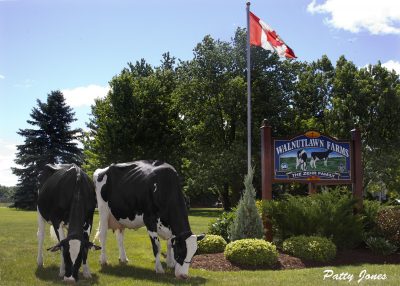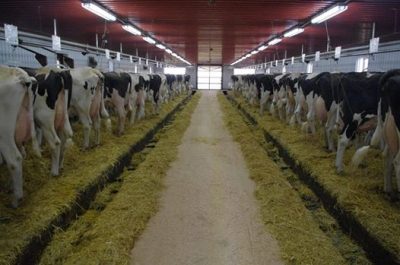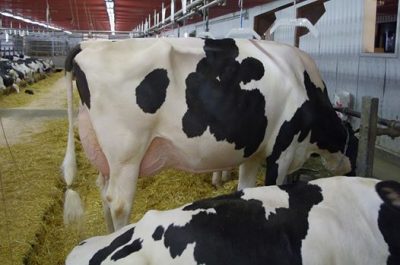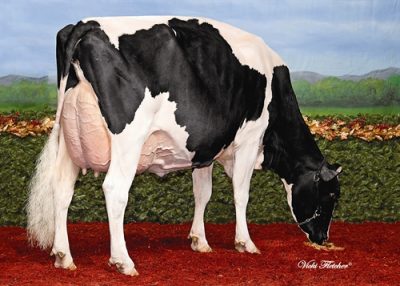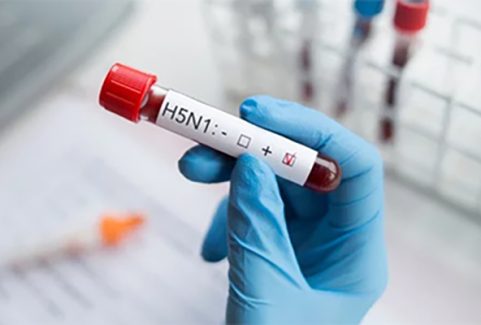Walnutlawn Farms achieves a Master Breeder Award!
Was achieving your Master Breeder shield a goal you set when you 1st started breeding cattle?
Yes, the desire to breed high type cows that can milk has been there right from the beginning and a Master Breeder shield was definitely an initial goal
-Farm Operation –
Total # of animals – milking, and total: Approximately 60 milking cows and 170 head total
Herd Classification? 20EX, 39VG, 9 GP
Herd Production? 10 628M 438F 335P (228-253-234)
Acres – forage and grains grown? 390 acres owned, we grow hay and corn for ourselves as well as the remaining corn and all of the soybeans for cash crop
Type of feed fed? High moisture corn, corn silage, haylage, hay, protein supplement
Feed bought? Protein supplement
People involved? Burnell and Darlene Zehr along with son Adam and Bethany and family (Blake 6, Reegan 4 and Easton 1)
Farm operation improvements/renovations over the years?
Summer of 2011 we switched to liquid manure and dug a manure pit and then in 2013 summer we tore down the old bank barn which housed the heifers and built a new heifer barn and a calf barn with a robotic feeder.
Most influential cow family(s) that helped earn the Master Breeder Shield? Was she purchased or bred?
Walnutlawn Gibson Jessica EX 94 3E. Her granddam Rubyholme Blackstar Jewel was a deep pedigreed cow purchased from our neighbour when his herd dispersed and we have many branches of the Jewel family that have produced many EX cows with the Jessica branch of the family certainly being the most influential. Jessica herself is a Cow of the Year nominee this year.
Walnutlawn Raider Nectarine (an All Canadian nominee) and her daughter Astre Apricot who was All-American and All Canadian in the late 90’s have headed up the “Fruit” family and they also have made a major contribution to the shield.
If you purchase cattle, what do you look for? If you haven’t purchase cattle in a while, when was the last animal bought?
We have always looked to purchase a high classifying cow from a deep pedigree. In the more recent years we definitely still look for that but since genomics has proven itself to us we look at the numbers of a cow as well when looking to buy. We have specifically purchased high classifying cows, from brand name cow families with high conformation or PTAT numbers and we think we have a little bit of a niche market with the high type numbers. We have found that we are better off to make fewer purchases and save our pennies to buy a cow that we think is exceptional rather than a bunch of good ones.
Do you flush? When did you start? How often do you flush? Export/sell or implant?
We usually flush 1-3 cows monthly, sometimes skipping a month or 2 depending on what cows are ready. We implant embryos in approx. 80% of the heifers and lower end of the milking herd. We have sold embryos around the world with Australia being an exceptional market in the last few years.
Future Goals?
There are too many to list all of them!
-Breed an influential bull
-I would love to breed a nominated All Canadian Breeder’s Herd someday. I have a lot of respect for the herds that can breed and develop homebred cows who can compete at the “big” shows and to do it year after year like some of them do is impressive!
-Third Master Breeder shield
-Breed a Royal Grand Champion
Sire that worked well and you feel had the most impact on your herd? Sheik, Raider, Dundee, Goldwyn
Bulls used, what do you look for in a sire?
Type, fat percentage, and more attention is being paid to fertility and SCC. Right now we are using homebred bulls Solomon and Blake as well as Doorman, Dempsey, Gold Chip, and High Octane along with some new high genomic type young bulls.
Have you changed your breeding philosophy over the years at all?
As mentioned earlier we have used genomics heavily in the last few years because it proved itself to us. We are still breeding for the same kind of cow that we always have but we are using different methods such as genomics to get us there. In order to have our bulls with high type numbers accepted to AI we have to have a decent LPI to go along with the type numbers so we are doing the odd flush here and there to some “numbers” bulls where in the past we wouldn’t have done that. Because of our confidence in genomics we are also flushing some virgin heifers with (the right) high numbers which is something we NEVER would have done in the past, as well as using young bulls as mating sires for flushing.
Before achieving your Master Breeder Shield what would you consider your greatest accomplishment as a Dairy Farmer and Holstein Breeder.
It’s hard to pick one thing specifically but a few accomplishments would be:
Astre Apricot winning All Canadian and All American, that was a huge thrill!
Breeding over 70 EX cows.
Putting a few bulls in AI.
Statistique de la ferme
Total de têtes (vache en lactation et nombre total) 60 vaches en lait et 170 animaux totaux
Classification du troupeau 20EX 39TB 9 BP
Production du troupeau 10,628kg 438G 335P (228-253-234)
Nombre d’acres cultivés – foin et grain : 390 acres qui nous appartient, nous cultivons foin et maïs pour nos besoin et le surplus de maïs et le soya cultiver son vendus Type d’aliment soigné Maïs grain humide, maïs d’ensilage, foin, supplément protéique
Achetez-vous du fourrage ou êtes-vous auto suffisant ? Le supplément
Nom des gens impliqué dans l’entreprise : Burnell et Darlene Zehr avec leur fils Adam et Bethany & leur famille (Blake 6, Reegan 4 et Easton 1)
Est-ce que la reconnaissance de votre titre de Maître Éleveur était un but lors de vos débuts en élevage ?
Oui, le désire d’élever des vaches avec de hautes conformations et qui pouvaient produire beaucoup de lait était présent du début, et d’être Maitre Éleveur était définitivement un but initial.
La ou les familles les plus importantes dans votre titre de Maître Éleveur. Est-ce des vaches achetées ou élevées ?
Walnutlawn Gibson Jessica EX 94 3E. sa grand-mère Rubyholme Blackstar Jewel était une vache avec un gros papier que nous avons acheté à la dispersion de troupeau de notre voisin et nous avons plusieurs descendants de la famille de Jewel qui ont donné des EX, et la branche de la famille de Jessica est certainement celle avec le plus d’influence. Jessica elle-même est nominée ‘’Vache de l’Année’’ pour 2014.
Walnutlawn Raider Nectarine (une nominée Toute-Canadienne) et sa fille Astre Apricot qui fut Toute-Canadienne & Toute-Americaine dans la fin des années 90 a fait remarquer la famille des ‘’fruits’’ et ont une grosse influence dans la contribution de la plaque.
Faites-vous des récoltes embryonnaires ? Quand avez-vous commencé ? À quelle fréquence faites-vous des récoltes ? Les vendez-vous ou implantez la majeure partie ?
Nous faisons des récoltes en général sur 1-3 vaches par mois, et des fois nous passons 1 mois ou deux, dépendamment des vaches si elles sont prêtes ou pas. Nous implantons environ 80% des embryons dans les taures et dans les moins bonnes vaches du troupeau. Nous avons vendu des embryons à travers le monde et surtout en Australie, qui a été un marché exceptionnel dans les dernières années.
Si vous achetez des animaux, que regardez-vous le plus.
Nous avons toujours regardé pour acheter des vaches hautement classifiées venant de généalogie profonde. Dans les dernières années, nous avons définitivement regardé pour ces aspects, mais avec l’arrivée de la génomique qui a fait ses preuves chez nous, nous regardons également les chiffres avant d’acheter. Nous avons spécialement acheté des vaches avec de hautes classifications, de noms reconnus avec de bonnes conformations et haute en PTAT et nous pensons que nous avons un petit marché pour les animaux avec des chiffres hauts en conformation. Nous pensons que nous sommes mieux de garder nos sous pour acheter une vache exceptionnelle que plusieurs bonnes vaches.
Quels sont le ou les taureaux qui ont eu un gros impact dans votre troupeau ? Sheik, Raider, Dundee, Goldwyn
Quels taureaux utilisés vous présentèrent? Que recherchez-vous d’un taureau? diriez-vous que vous êtes plus un troupeau axé de conformation, génomique, production ou une combinaison de tout. Conformation, Gras, pourcentage, et une attention particulière pour la fertilité et les CCS. Présentement nous utilisons nos propres taureaux Solomon et Blake ainsi que Doorman, Dempsey, Gold Chip, et High Octane avec quelques jeunes taureaux haut en génomique.
Avez-vous changé votre philosophie d’élevage à travers les années? Pourquoi?
Comme je l’ai mentionné, nous avons utilisé de la génomique chez nous, car elle a fait ses preuves dans notre troupeau. Nous continuons d’élever pour avoir le même genre de vaches, mais nous utilisons différentes méthodes comme la génomique pour nous y amener.
Avant d’être récompensé de votre titre de Maître Éleveur, quel serait pour vous le plus grand accomplissement en tant que producteur laitier et éleveur ?
il est dur de ne choisir d’un accomplissement, mais quelques un serait : Astre Apricot qui fut All Canadian et All American, ce fut toute une joie, d’avoir élevé plus de 70 vaches EX et d’avoir envoyé quelques taureaux dans des centres d’insémination.
Vos futurs objectifs?
Il y a en beaucoup !
Élever un taureau avec beaucoup d’influence sur la race,
J’adorerais élever un troupeau d’éleveurs qui serait Nominée All Canadien. J’ai beaucoup de respect pour ceux qui arrivent à élever et amener leurs animaux ;à des hauts grades dans les expositions nationales, comme certains qui le font d’année en année.
Avoir une 3e plaque de Maître Éleveur
Élever une Grande Championne à la royale.

